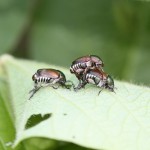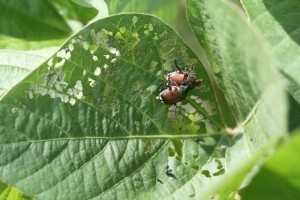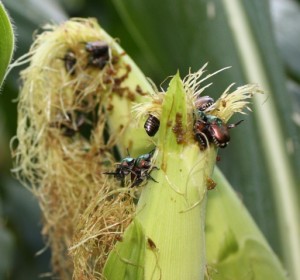 Japanese beetles are getting more and more numerous, and like a lot of insects this year, populations are ahead of schedule. Japanese beetles will feed in corn, soybean and cotton. These showy beetles often hang out in groups and draw a lot of attention. Fortunately, they only occasionally cause yield loss in field crops. The beetles will feed on leaves, flowers and corn silks. Japanese beetles have a wide host range which includes many ornamental plants. They were introduced into the northeast U.S. nearly 100 years ago and have been slowly spreading south and east ever since. They only have one generation per year, and the adults started emerging last week. Adults will continue to emerge for several more weeks and will persist into July. Larvae are white grubs that feed underground and are sometimes a pest of turfgrass.
Japanese beetles are getting more and more numerous, and like a lot of insects this year, populations are ahead of schedule. Japanese beetles will feed in corn, soybean and cotton. These showy beetles often hang out in groups and draw a lot of attention. Fortunately, they only occasionally cause yield loss in field crops. The beetles will feed on leaves, flowers and corn silks. Japanese beetles have a wide host range which includes many ornamental plants. They were introduced into the northeast U.S. nearly 100 years ago and have been slowly spreading south and east ever since. They only have one generation per year, and the adults started emerging last week. Adults will continue to emerge for several more weeks and will persist into July. Larvae are white grubs that feed underground and are sometimes a pest of turfgrass.
Cotton: Cotton is not typically a preferred host for Japanese beetles. Treatment would typically be recommended only if 25% or more defoliation has occurred. Until this week, I had never recommended a treatment for Japanese beetles on cotton. However, one caller from Gibson County reported 4-5 beetles per plant on 1-2 leaf plants. This is very unusual and certainly enough beetles that severe defoliation is possible. Synthetic pyrethroids provide good control. I have less experience but would also expect Centric or imidacloprid to provide good control.

Soybean: I don’t think there are any proven examples of yield loss caused by Japanese beetles in West Tennessee. However, I’ve observed a few examples where they have caused enough defoliation in soybean to exceed our treatment thresholds. In soybean, treatment would be recommended prior to bloom if defoliation exceeds 30% (dropping to 20% once the plants are blooming). Synthetic pyrethroids such as Asana XL, Baythroid XL, Brigade, Mustang Max and Karate/Warrior would all be expected to provide control.

Corn: Although some leaf feeding can occur in corn, the only real concern is excessive silk clipping which could reduce pollination. Treatment is generally not recommended in corn unless multiple beetles are found per ear. A common treatment threshold used by our neighboring states to the north is an average of 3 beetles per ear during pollination. Most pollination occurs within 7 days after silking begins. Keep in mind that infestations are often worst along field edges, and silks have to be clipped prior to pollination for feeding to have any effect. Even then, clipped silks can re-grow if they are not pollinated.
My technician/graduate student (Sandy Steckel) has been working on a project with Japanese beetles in field corn. The results of her work suggest that the threshold above (3 beetles per ear) is probably a pretty good one. At one location last year, we did not measure an effect on yield when as many as 8 beetles per ear were caged on silks. At a second location that was under severe stress, a 33% reduction in yield was observed when 8 beetles were caged on ears during the first five days of silking; 4 beetles per ear caused about a 10% yield loss that was not statistically significant; and 2 beetles per ear had no effect. Interestingly, extreme silk clipping reduced the number of kernels per ear, but the plants compensated by increasing kernel size.


One thought on “Here Come the Japanese Beetles”
Comments are closed.